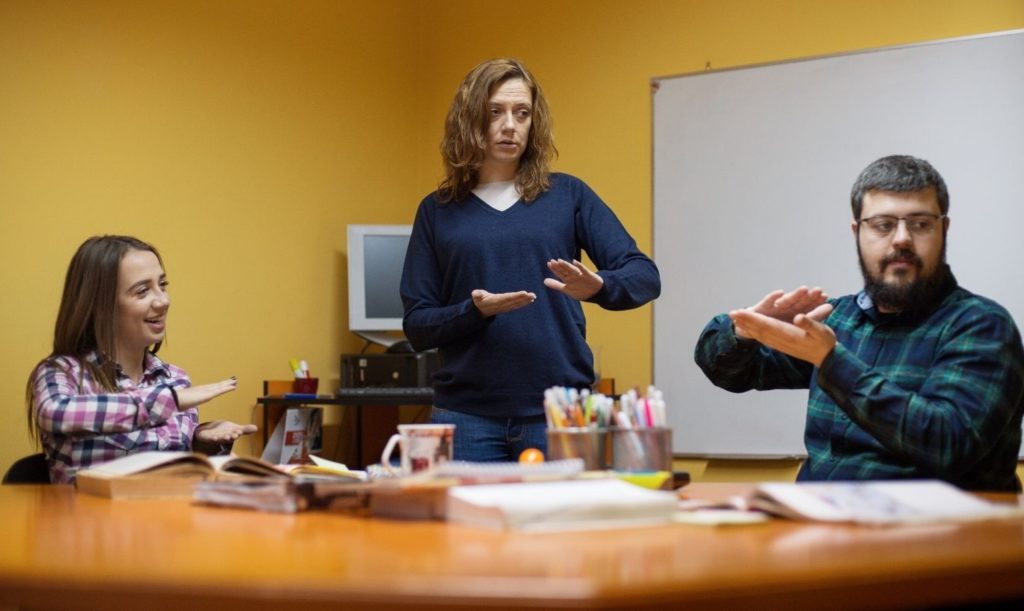Sign language is a method of communication primarily used by people that are deaf or hard of hearing. It uses a sequence of hand movements and gestures, often combined with exaggerated mouthing of the words. This is used as an alternative to lip-reading for deaf people, as lip reading can be difficult and often inaccurate.
There are a number of different sign languages found across the world. It is hard to quantify the number of people who speak sign language as the proficiency levels can vary massively. As well as this, there are no official registers for sign language, meaning that there could easily be far more or far fewer speakers than we estimate.

The figures quoted here are from Ethnologue: Languages of the World. This is an online and print annual reference publication used to give information and statistics on languages of the world. It has been an active publication since 1951.
Across the globe, it is estimated that there are more than 70 million deaf people that use some variation of a sign language as their primary form of communication. Of these people, it is estimated that 80% or more reside in developing countries. Across the globe, in excess of 300 different sign languages are in operation.
History of Sign Language
Sign language use dates back at least 2,000 years across the Middle Eastern and Western world. Since the early part of the 19th century, deaf people have implemented a rudimentary gesturing form of communication at cultural and sporting events.
In 1951, the first World Deaf congress was held, at which the World Federation of the Deaf was established. Here they discussed the importance of an international language for ease of communication.
It was not until 1973 that a sub-branch of the WFD, the Commission of Unification of Signs, published a standardized sign language vocabulary. This was compiled of “naturally spontaneous and easy signs in common use by deaf people of different countries.”
American Sign Language
ASL is believed to have descended from Old French and Martha’s Vineyard sign languages. This is predominantly spoken across America but can be found across the world. There are believed to be around 1 million speakers of ASL, who use it as their primary form of communication.
The American School for the Deaf was founded on April 15, 1817. This date is now celebrated and marked by American Sign Language Day every year.
British Sign Language
British sign language is descended from BANZSL (British, Australian, and New Zealand Sign Language). It is native to the United Kingdom and it is believed that there are around 80,000 speakers.
Indo-Pakistani Sign Language
This is believed to be related to Nepalese sign language, and other sign languages found in the same region. There is no legal recognition of this as a language, despite being used widely across Bangladesh, India, and Pakistan. It is estimated that there were 6,300,00 speakers of this sign language in 2019.
Indonesian Sign language
This is believed to have evolved from the French sign language. It is native to Indonesia and there are an estimated 900,000 speakers in this region.
Russian Sign Language
This too is believed to have descended from the French sign language. It is native to Moldova, Bulgaria, Russia, Ukraine, Kazakhstan, and Belarus. It is also spoken across Lithuania, Latvia, and Estonia. In these regions, it is estimated that there are around 715,000 speakers.
Brazilian Sign Language
This is what is referred to as a language isolate. This means that it cannot be classified into a larger group of languages like most others. This sign language is native to Brazil and has been a legally recognized language since April 2002. There are approximately 600,000 speakers across Brazil.
Spanish Sign Language
The origin of this sign language is unknown. It is native to Spain, with the exceptions of Valencia and Catalonia. This sign language is officially recognized by the Spanish Government and there are an estimated 523,000 speakers.
Egyptian Sign Language
This branch of sign language evolved from the Arabic sign languages. It is exclusively spoken across Egypt. There are believed to be 474,000 speakers of this language.
International Sign Language
This is also sometimes referred to as International Sign, Gestuno, International Gesture, and International Sign Pidgin. The name Gestuno was chosen to reference gesture and oneness. It is a pidgin language, meaning that it is a highly simplified form to allow communication between people who speak different languages.
This is used in a number of different situations, but most commonly during international meetings. Examples of this are the World Federation of the Deaf congress meetings, the Deaflympics, and informally during travel.
When it was first used in Bulgaria in 1976, many deaf people had no idea what was being said. Since this point, it has been informally modified by hearing and deaf interpreters. Their modifications included incorporating grammatical rules, movement repetition, role shifting, classifiers, and the use of signing space. The vocabulary was also modified to include signs that are more easily recognized.
The first training course for International Sign Language was held in Copenhagen in 1977. This was to help prepare the interpreters for the 5th World Conference on Deafness.
International Day of Sign Languages
This is held every year on the 23 September and is a holiday recognized by the United Nations. The holiday is an opportunity to support and protect the linguistic identity and cultural diversity of deaf people and sign language users.
The date was chosen as this is the same day of the year as the World Federation of the Deaf was formed. The holiday was first celebrated in 2018 as part of the International Week of the Deaf celebrations.
This week-long celebration has been running since September 1958. It has now become a global movement of the unity of deaf people and the concerted advocacy to raise awareness of the day-to-day issues that deaf people face.
